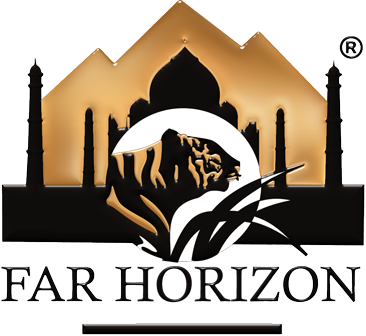Rajasthan with Village, Jungle & Desert Safari
more_vert
Introduction
Regarded as a ride on the sands of time,the state of Rajasthan is home to the chivalrous Rajputs, and its battle-scarred heritage is ingrained with pride and tradition. India's quintessential land of medieval forts, palaces and tigers, and kaleidoscopic festivals, Rajasthan really is the jewel in India's crown.
Far Horizon takes you on a journey through the villages, jungles and desert of Rajasthan along with the visit to the architectural wonders of Delhi- the foundation of Mughal Empire, Agra, Majesty of the Taj and Mumbai, the cosmopolitan hub of India. Immerse yourself into the varied hues of villages and golden-sand deserts. You will be astounded by the zeal with which Rajasthani people live their life. People of Rajasthan are as colourful as the state itself; they are very fun-loving, talkative, devoutly religious and friendly. Their gentle and generous nature will make you feel at home and special as they take pride in entertaining their guests.
Tour Highlights
- A wonderful tour & safari covering Delhi, Agra, Gadoli in the Aravalis, Tigers at Ranthambhor, Jaipur, Jodhpur, Jamba in the Thar Desert & Mumbai
- Explore the villges in the Aravali Hills, Tigers and other wildlife, Tribals in the Thar Desert
- Unesco World Heritage Sites at Delhi, Agra, Jaipur & Jodhpur
- Sunrise Visit of Taj Mahal
- Unique accommodation at a village retreat and on-top of a sand dune in the heart of the Thar Desert
- Prices on request
Destinations Covered
Delhi
The City of GloryDelhi is said to be one of the oldest existing cities in the world, along with Jerusalem and Varanasi. It is the Capital Territory of India and a modern-day citadel that's dotted with ancient monuments.
History and Culture
Legend estimates it to be over 5,000 years old. Over the millennia, Delhi is said to have been built and destroyed 11 times. The oldest alleged incarnation of the city shows up in the Indian mythological epic Mahabharata as Indraprastha.
Agra
The Majesty of the TajAgra is the city of the Taj Mahal, in the north Indian state of Uttar Pradesh. Agra has three UNESCO World Heritage sites, the Taj Mahal, Agra Fort in the city and Fatehpur Sikri on the outskirts of Agra. There are also many other buildings and tombs from Agra's days of glory as the capital of the Mughal Empire.
Gadoli, Aravali Hills
The Classical Indian Village in the Golden TriangleSet in the heart of India and nestled amidst the Aravalis, Gadoli village is located in the rural countryside of Rajasthan. One can easily move around on camels or by camel carts. Marvel at the beautiful scenery and potentially spot some of the desert wildlife. The vibrant culture and rich heritage of this place draws innumerable tourists from across the globe.Tucked away within a valley inside the Aravali Hills, home to the community of Meena Tribals, the joy and spirit of rustic life is palpable on the lively faces of the village folks.
Ranthambore
The Great Wildlife AdventureJaipur
The Pink CityJaipur is the largest city in Rajasthan and was built in the eighteenth century by Sawai Jai Singh as India's first planned city. Jaipur is a major tourist attraction amongst Indian as well as international travellers. Jaipur is often called the Pink City in reference to its distinctly colored buildings, which were originally painted this color to imitate the red sandstone architecture of Mughal cities. The present earthy red color originates from repainting of the buildings undertaken for a visit by the Prince of Wales in 1876.
Jodhpur
A Rhapsody in BlueLocated on the foothills of a sandstone hillock, the city of Jodhpur seems like an oasis in the vast desert. The city is known by three names as the "Sun City" for the bright, sunny weather it enjoys all year. It is also referred to as the "Blue City" due to the vivid blue-painted houses around the Mehrangarh Fort.
Jamba, Thar Desert
The Serene Desert LandscapeIn the distant reaches and vast expanse of the Thar Desert, far off the beaten tourist trail is the unique village called Jamba. It is located in Phalodi Tehsil of Jodhpur district in Rajasthan, India. This is a perfect place to get away from the big cities and enjoy the solitude of the desert life.
Mumbai
The City of DreamsIndia’s largest port, its commercial and industrial center, as well as fashion capital and heart of Bollywood (India’s thriving movie industry), Mumbai is an endlessly fascinating hive of activity. A jumble of captivating contradictions, grand colonial architecture rubs shoulders with chaotic bazaars, trendy restaurants, exclusive boutiques, slums and shanty towns, all interspersed with beautiful, tropical palm trees. A shopper’s haven, this bustling cosmopolitan metropolis offers anything from pavement stalls and ancient markets to glitzy malls and designer outlets.
Detailed Itinerary
- Day 1 Arrive Delhi
- Day 2 Delhi
- Day 3 Delhi – Agra
- Day 4 Agra - Gadoli
- Day 5 Gadoli
- Day 6 Gadoli - Ranthambore
- Day 7 Ranthambore
- Day 8 Ranthambore – Jaipur
- Day 9 Jaipur
- Day 10 Jaipur – Jodhpur
- Day 11 Jodhpur – Jamba
- Day 12 Jamba
- Day 13 Jamba
- Day 14 Jamba – Jodhpur & flight to Mumbai
- Day 15 Mumbai
- Day 16 Departure


























